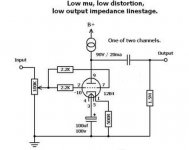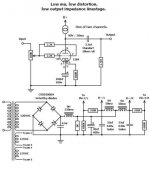Hello all.
Im toying with the idea of building a simple IDHT preamp to clear up some spare parts off my shelves.
Im looking for a nice linear IDHT with a lowish output impedance (less than 5K).
I have thought about a 12B4, 6V6, 6Y6, and 1626 tubes.
The amp the preamp would be driving has an input impedance of 10K.
Any recommendations and thoughts are welcome.
Im toying with the idea of building a simple IDHT preamp to clear up some spare parts off my shelves.
Im looking for a nice linear IDHT with a lowish output impedance (less than 5K).
I have thought about a 12B4, 6V6, 6Y6, and 1626 tubes.
The amp the preamp would be driving has an input impedance of 10K.
Any recommendations and thoughts are welcome.
Last edited:
12B4! Signal schematic provided. For a 10 Kohm downstream load, a high quality, cascode, CCS is in order.
BTW, the 100 muF. 'lytic is not a cathode resistor bypass. It grounds the heater CT and is part of biasing said heater off B+, for hum suppression.
This Triad trafo is "perfect" for feeding 2X 12B4 heaters.
BTW, the 100 muF. 'lytic is not a cathode resistor bypass. It grounds the heater CT and is part of biasing said heater off B+, for hum suppression.
This Triad trafo is "perfect" for feeding 2X 12B4 heaters.
Attachments
Thank you for the reply Eli.
The 12B4 is at the top of my list because of its low output impedance. Plus a lot of people seem to like it.
The circuit you posted is pretty much what I plan on doing with any tube I end up using.
If I do indeed end up using the 12b4, there is a question I have about the schematic. A lot of schematics for 12b4 preamps (including the one you posted) all seems to have pretty high bias voltages of around 10v or higher. That can't be a coincidence.
Why bias the tube so high? To me it looks like as long as you stay away from the 0v line, the tube is moderately linear regardless of where you bias it. So why not bias it at 4v and lower the B+/Plate voltage requirements along with the thermal dissipation through the CCS?
I feel like there is some super secret I am missing.
The 12B4 is at the top of my list because of its low output impedance. Plus a lot of people seem to like it.
The circuit you posted is pretty much what I plan on doing with any tube I end up using.
If I do indeed end up using the 12b4, there is a question I have about the schematic. A lot of schematics for 12b4 preamps (including the one you posted) all seems to have pretty high bias voltages of around 10v or higher. That can't be a coincidence.
Why bias the tube so high? To me it looks like as long as you stay away from the 0v line, the tube is moderately linear regardless of where you bias it. So why not bias it at 4v and lower the B+/Plate voltage requirements along with the thermal dissipation through the CCS?
I feel like there is some super secret I am missing.
Are you also considering a variety of other tubes with higher output impedance - EF86 in triode etc - with a cathode follower? Gives you a lot of choice?
It's been some time since I worked that design up for a fellow who posts under the moniker Buzz. I was asked to use parts that were on the "pile". Between the 12B4 datasheet and what items were available, I came up with a pseudo choke I/P filter/pseudo dual mono PSU.
A "tall" B+ rail voltage? I don't think so. We fought for every last volt, to ensure proper CCS operation.
For working into the 10 Kohm IHF "standard" load, I suggest a 4.7 μF. metalized polypropylene (MKP) part bypassed by a 0.47 μF. 716P series "Orange Drop" as the O/P coupling capacitance.
A "tall" B+ rail voltage? I don't think so. We fought for every last volt, to ensure proper CCS operation.
For working into the 10 Kohm IHF "standard" load, I suggest a 4.7 μF. metalized polypropylene (MKP) part bypassed by a 0.47 μF. 716P series "Orange Drop" as the O/P coupling capacitance.
Attachments
Does 6SN7 fit the bill? I very much like the subminiature valves like 6N16B, 6S6B and 6S3B for this duty, and I believe they are analogous to 6SN7.
I am no expert though, and I think the ra may be in the 4k to 5k range, so toward the upper bounds of your requirements.
Also, not everyone likes wire ended valves 😀
I am no expert though, and I think the ra may be in the 4k to 5k range, so toward the upper bounds of your requirements.
Also, not everyone likes wire ended valves 😀
Does 6SN7 fit the bill?
Not wired common cathode, in order to obtain some voltage gain. The plate resistance (RP) of the triodes found in 6SN7s is roughly 7000 Ω. Good engineering practice makes the NET load the triode's anode works into at least 3X RP. The IHF "standard" 10 Kohm load is a non-starter. However, it gets worse, as the downstream load is (insofar as AC is concerned) in parallel with the anode load. Remember, impedances in parallel net to less than any of the composite parts.
1/Znet = 1/Z1 + 1/Z2 ...
I built a 12B4 preamp years ago and it was hard to find tubes that weren't microphonic. Actually, all the tubes I found were microphonic to some degree. During the process I acquired, perhaps, 20 examples and only a few were quiet enough to suit my taste. YMMV.Im looking for a nice linear IDHT with a lowish output impedance (less than 5K).
I have thought about a 12B4, 6V6, 6Y6, and 1626 tubes.
The amp the preamp would be driving has an input impedance of 10K.
I did like the sound, though. It was very full, especially in the upper bass, lower mid region. Meaty.
Earlier this year I built a simple junkbox preamp using 1626s. My inspiration was based on all of Andy Evans' comments, posted over many years, praising their sound. I even call it the "Boogie Factor 1626" in his honor. (Thanks, Andy!)
His enthusiasm is linked to the type of music being played. He found the 1626s to work especially well with jazz and funky R&B. He uses other tubes, however, because he prefers a more delicate and detailed sound for the genres he listens to.
I was breadboarding a variety of tubes and, after trying the 1626, I found his observations to be spot on. In addition to jazz and funky stuff I also listen to a lot of Americana, lighter rock, folky stuff, singer-songwriter, etc. And, while I haven't tried it with classical, I've got a Yo Yo Ma album that sounds fantastic too.
My breadboarding focussed on low mu tubes because I don't really need gain. I built a "passive preamp", which works fine too but I prefer the liveliness of an active stage.
I also wanted fairly low output impedance. In most cases I don't really need that, since I use tube amps and don't drive long cables. But I do have one SS power amp, a Yamaha M-60, which has an input impedance of 20k and I wanted to be able to drive it without issue.
The other tubes that I liked a lot were the Russian 2P29L in triode and the 6V7G. I tried the 6V6 and wasn't particularly impressed but I didn't spend much time playing with it. It also had some issues with being microphonic.
I build really simple, low parts count, stuff so, if you're doing a more elaborate build (which most everyone here seems to do) you might have better results with tubes that I had issues with.
I've got schematics for all of these, if you're interested. They're nothing particularly special, although I do use battery grid bias in the Boogie Factor and the 2P29L. No doubt they have some flaws, I'm not a designer by any stretch.
Last edited:
Charlie, have you tried silicone rubber "O" rings mounted at the level of the mica wafers on your microphonic 12B4s? The tweak can be useful, at least some of the time.
My experience with 12B4s was years ago but, as I recall, I did try some type of O-rings and it did help a bit. It wasn't a huge problem with the least microphonic tubes but having to go through that many to find some that worked was a hassle.Charlie, have you tried silicone rubber "O" rings mounted at the level of the mica wafers on your microphonic 12B4s? The tweak can be useful, at least some of the time.
I much prefer using tubes that don't require heroic efforts to quell issues with microphonics or hum.
I had to take that preamp out of service. It was built in the chassis of a reverb amp that was pulled from on old Zenith console stereo. It always ran really hot and, between the microphonics and the heat, I decided to stop using it.
Years later, I took a close look at the PT specs listed in the Sams which explained the heat. The PT is rated for 20mA and I was drawing considerably more.
 Doh!
Doh!Not wired common cathode, in order to obtain some voltage gain. The plate resistance (RP) of the triodes found in 6SN7s is roughly 7000 Ω. Good engineering practice makes the NET load the triode's anode works into at least 3X RP. The IHF "standard" 10 Kohm load is a non-starter. However, it gets worse, as the downstream load is (insofar as AC is concerned) in parallel with the anode load. Remember, impedances in parallel net to less than any of the composite parts.
1/Znet = 1/Z1 + 1/Z2 ...
Yes. Agreed. That's basic, first class of the year, electronics....
I am just not familiar with 6SN7 and mentioned it, in case it may have been suitable.
The 6S19P mentioned is probably slightly over doing it, the other way.
Very low ra or rp (not Ra or Rp, which is the anode load), and very low mu, not much gain to be had there....
If we are going to be critical, let make sure we get the nomenclature correct, for those that are learning the terminology.
Last edited:
A 6SN7 would actually "work". There are plenty of ways you could build it and get the output impedance nice and low. But the thing that kills it for me is the gain. Yes I could use cathode degeneration or feedback to lower the gain, decrease the output impedance, and lower the distortion, but that isn't really something I want to have to deal with.
And thank you everyone for the responses. I decided to get both the 1626 and 12B4 tubes so I can test them side by side. They have somewhat similar operating conditions, so it should be fairly simple. 😀
And thank you everyone for the responses. I decided to get both the 1626 and 12B4 tubes so I can test them side by side. They have somewhat similar operating conditions, so it should be fairly simple. 😀
- Home
- Amplifiers
- Tubes / Valves
- Best IDHT tube for preamp?

